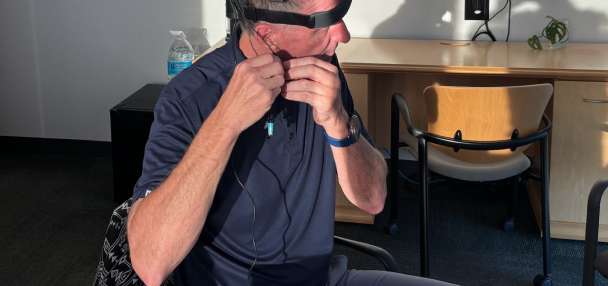Estimated read time: 5-6 minutes
This archived news story is available only for your personal, non-commercial use. Information in the story may be outdated or superseded by additional information. Reading or replaying the story in its archived form does not constitute a republication of the story.
Mary Roach is a funny woman who investigates deadly serious subjects. In her new book, "Spook: Science Tackles the Afterlife" (Norton, $24.95), Roach takes on the ephemeral history of scientific attempts to find out if there's really, truly, life after death.
Sound like a where-angels-fear-to-tread topic? Her last book, a New York Times best seller, was "Stiff: The Curious Lives of Human Cadavers," about the many uses of ... dead people. Grim material, but Roach has the sense of humor for it: She dedicates "Spook" to "my parents, wherever they are or aren't."
Roach ranges far and wide in "Spook," traveling to India to look into reincarnation and England to take a course in how to be a medium. She is a skeptic, but comes to some surprising conclusions in "Spook."
As a scientist would say, the data are inconclusive (for one thing, no one has ever come back to give a report).
In the spirit of the season, when spooks rule, we asked Roach some questions. She spoke by phone from her home in Oakland, Calif.:
Q: Why is the field of investigating the afterlife littered with charlatans?
A: You have this ready supply of people who are ready for the taking - people who are lost, aching, saying, `Can I get one more message through?' That sets up the situation. There's not a lot of overhead if you're a bogus medium; you just need a business card and an ad in the Yellow Pages.
Q: Who was your favorite charlatan in the book?
A: The medium Helen Duncan, by far - she was a large, histrionic woman. In one of her seances she came out naked in her ectomplasmic veil - she would pass out, swoon, wet herself. She was quite a character. She even cooperated with Harry Price, an investigator who was essentially debunking her. He paid enough that she would go up to his lab and take the 200 quid.
Q: Is the subject of existence of the afterlife under-studied because it automatically sets the researcher up for ridicule?
A: It's two things. It's that, and also that it's very difficult to get funding. You can't go through any conventional channels, like the National Institutes of Health.
There was a brief period in the '40s and early '50s when the paranormal was part of accepted science. It was a little fringy - people doing telekinetics, trying to influence the working of a machine or the falling of dice. But no one got the solid knock-you-dead results that would have gotten more funding.
Q: The paranormal is everywhere right now - mediums, spooks and aliens seem to dominate prime-time television. How do you account for their current popularity?
A: I can't for the life of me figure out why it's going on now.
There was a lot of activity after World War I, because so many people had lost sons in World War I. Sir Arthur Conan Doyle (creator of Sherlock Holmes) lost a son.
Now? I really don't know. People are moving away from science, questioning evolution. Maybe it's part of that whole abandonment of critical thinking. I don't know if there's something in the climate, with the religious right being so prominent. I had no idea when I was writing the book that it was coming on like this.
Q: You give rural India as an example of a place where life is short and the belief in an afterlife (in this case, reincarnation) is abundant. Is there a correlation between "life is short" and "afterlife looks good"?
A: Maybe it's a way of coping with the incredible number of children that die. People are a little more invested in their beliefs in the afterlife as a happier place.
Q: What was the logical progression from "Stiff" to "Spook"?
A: It was more a case of my stumbling onto Duncan Macdougall (a physician and scientist who, in the early 20th century, tried to determine whether the soul had left the body by weighing bodies shortly before and right after death. Macdougall's experiments became the basis for the belief that the soul weighs 21 grams).
Who was this guy, who felt that medicine and science could prove that the soul has substance? That sparked my interest in other folks who had tried to prove something as ephemeral and profound as the soul and the afterlife.
Q: At the conclusion of "Spook" you say you do believe in ghosts. What's the closest you've ever come to seeing a ghost?
A: I lived (with a boyfriend) in a flat that supposedly had a ghost. The woman who owned the building had supposedly died upstairs. One day I came down and there was a little candy heart that said `NO USE' on the table. The bowl of candy was elsewhere. I thought, wow, it was the ghost. I believed it and didn't believe it.
A few years later I'm writing "Spook." I thought, of course, David put it on the table as a quiet comment on the relationship. So I tracked David down by e-mail and I said, "I want to know, did you put the heart on the table?" He said absolutely not. I have no idea who put it there.
I haven't proved it to myself, but in the way that the heart was on the table - that seemed to be an option, that it was the ghost. I believe in the way that you can believe without knowing.
The rational part of me doesn't believe, but the irrational part of me does.
---
(c) 2005, The Seattle Times. Distributed by Knight Ridder/Tribune News Service.







